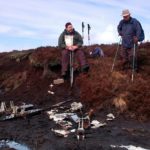Wellington bomber Z8799
‹ Return to Air Crash Sites

Wellington bomber Z8799 memorial
In the early hours of 16th November 1943, Wellington Z8799 piloted by Australian Flight Sergeant Joe Timperon crashed on Aglezarke Moor, east of Chorley, Lancashire. Probable cause is often said to have been the build up of ice. Unable to pull out of a steep dive, the aircraft crashed on the moor killing all 6 on board. This was a night training exercise. The memorial plaque has the incorrect date of the crash, but a more recent plaque dedicated to the memory of Flt. Sgt. Timperon, placed on the 60th anniversary, rectifies that.
Crew;
Flt. Sgt. J. Timperon
Sgt. E.R. Barnes
Sgt. J.B. Hayton
Sgt. R.S. Jackson
Sgt. G.E. Murray
Sgt. M. Mouncey
Photo of the crash site here;
https://aircrashsites.co.uk/air-crash-sites-5/wellington-z8799-hurst-hill-lancashire/
EDIT 01 January 2024
There is a comment below, copied here from Sean Devaney who writes,
Hi, the records relating to this flight are slightly wrong I understand. The a/c took off from RAF Castle Donnington (now East Midlands Airport) on a cross country training flight. Although 28 OTU was at stationed at RAF Wymeswold, 28 OTU a/c used Castle Donnington airfield to take off and landings.
The a/c actually took of on 16th November 1942 and crashed some time after 02:00 ON 17th according to Police records.
16 comments on “Wellington bomber Z8799”
Leave a Reply Cancel reply
Image Information
-
Full Size: 2000×2799px
Aperture: f/9
Focal Length: 18mm
ISO: 200
Shutter: 1/320 sec
Camera: NIKON D40



I see none of them were officers, is that due to the shortage of them at that time of the war?
Lots of flights had no officer on board, bombing missions and training exercises alike, but how that was organised is maybe something someone can advise on?
Quite a substantial memorial, especially compared to some of the other sites you’ve shown
This monument is a few miles from the crash site, which is higher on the moor quite close to the prehistoric relic of Round Loaf, though there are no longer any visible remains. It is unusual to have a memorial like this. At most there might be a plaque on a rock or a cross maybe and the odd poppy. It was funded by the Rotary Club. The more recent plaque (2003) looks like it was added by the family of the Australian skipper.
Great history ,Ian , as ever.
I think (and may be wrong but….) the RAF started to use uncommisioned officers to fly planes fairly early in the war due to the hefty losses in the battle of britain and the later bombing raids , the first of which were very costly in lives .
Makes sense.
It’s unimaginable how they did it, knowing that every day there was a good chance they be killed. hard to understand that scale of loss.
I love coming here Ian and getting all of this history, thank you for sharing ^.^
On the issue of NCO Aircrew, the normal route in WWII would be for enlisted men to volunteer for aircrew training following basic training, and be accepted provided they were suitable both physically and academically. The RAF needed Navigators, Wireless Ops, Gunners etc. as well as Pilots, and they would be assessed and allocated duties according to the RAF’s needs and the man’s skills. For example, those good at maths would probably be selected for Navigator training.
On completion of their aircrew training a selected few might be offered commissions, though the majority would be given NCO ranks. Some NCO aircrew might also be offered commissions later in their service, depending on how much they had impressed their superiors.
So. I think the majority of RAF aircrew in the later stages of the war would be NCOs, so an entire NCO bomber aircrew wouldn’t be at all unusual.
Thanks for that Tony.
Very nice memorial and shot Ian
I echo the sentiments of Redrocker 9, there must be lots of these memorials all over the country, and all with a story to tell, thankfully you have made a start, be nice if others were able to follow your lead.
Today I was in a cemetary and there was a section for WWII graves. It always amazes me how young these ‘fly-boys’ were – barely out of their teens and commissioned officers fighting the Battle of Britain and the like. I still cannot comprehend this. How on earth did we expect them at that age to have the experience of life to fight and lead others? And yet they all did, and died for us too. Makes me humble. and sad. And proud too. thanks Ian, my friend
My grandad (who was also in the RAF during the war) erected this monument. He took my grandma with him and she was repeatedly sent to a brook below to get water for the mortar.
They did a great job!
Hi, the records relating to this flight are slightly wrong I understand. The a/c took off from RAF Castle Donnington (now East Midlands Airport) on a cross country training flight. Although 28 OTU was at stationed at RAF Wymeswold, 28 OTU a/c used Castle Donnington airfield to take off and landings.
The a/c actually took of on 16th November 1942 and crashed some time after 02:00 ON 17th according to Police records.
Thank you Sean. I have copied your comment into the main text and also on the other page about this accident. It did not surprise me to read that, given the date on the memorial was itself incorrect.
Best wishes for 2024,
Ian